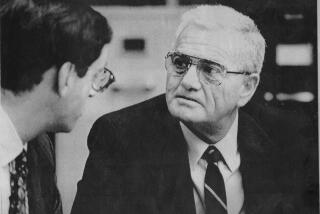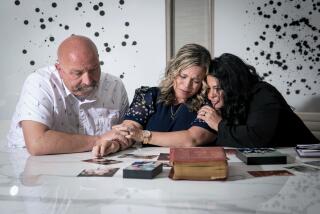Previously Unpublished Items Offer Insight Into Lizzie Borden Slayings : Crime: More than a hundred years before the O.J. Simpson case, the Borden family murders had it all--a loved one on trial, competing news leaks, the best defense team money could buy.
- Share via
BOSTON — A vicious double murder. A loved one charged. Sensational pretrial publicity. Competing news leaks. Gavel-to-gavel coverage. The best defense team money could buy.
The Lizzie Borden case had it all--a century before O.J. Simpson. Even a children’s rhyme has endured.
A new book shows just how much Americans got caught up in the Aug. 4, 1892, murders of Borden’s prosperous father and stepmother in their Fall River home.
“The Commonwealth of Massachusetts vs. Lizzie A. Borden: The Knowlton Papers 1892-1893,” available this month, is a collection of more than 300 previously unpublished letters and documents from the files of prosecutor Hosea Morrill Knowlton.
The book doesn’t contain any smoking guns--or bloody hatchets either. Those who believe Lizzie Andrew Borden was accused unjustly can continue to do so. So can those who feel she got away with murder.
But the letters and papers, donated to the Fall River Historical Society by Knowlton’s grandson in 1989, provide tantalizing firsthand material for historical researchers and Borden buffs about the case and public reaction.
Several people confessed to Knowlton. “Whiskey done the deed, not me,” one anonymous letter-writer said.
Another confession, dated eight days after the murders, was from a man claiming to be the illegitimate son of victim Andrew Jackson Borden and a woman later committed to an insane asylum.
Writing from an Albany hotel, the man said Abby Durfee Borden convinced her husband to renege on an agreement to pay the son a yearly stipend for his silence. His letter, like many of them, was replete with odd spellings and style.
“So to make a long story short the son Brooded over his and his mothers past troubles and resolved upon Vengeance, with the result known to all,” the man wrote, signing the letter Phillip Gordon Reed.
He says he disposed of the murder weapon, a “Lathers Hatchet,” by dropping it from a steamboat at a dock in the seaside mill town.
“No use to track me for it will be an utter impossibility to do so. At the hour this letter is mailed I shall take a train for hundreds of miles away,” he concluded.
If Knowlton investigated such a son, he left no written record, and the historical society was unable to find any documents showing he existed.
The book does lay to rest some misunderstandings about the case.
First things first: No 40 whacks, no forty-one. Abby Borden’s body bore 18 separate wounds, each described in the autopsy. Andrew Borden was struck 10 times in the head.
An analysis of the contents of the victims’ stomachs backs up testimony at the trial that Abby Borden was killed at least an hour earlier than Andrew Borden.
But perhaps most fascinating is the insight the book offers into widespread attention the case received from Americans of all political and social stripes.
The letters, mostly from residents along the Eastern seaboard, paint a picture of a different time, one without television, radio, telephones or automobiles, but one with plenty of public interest in crime drama.
People waited for days to read extensive excerpts from the trial in newspapers. Some published a full transcript of the statement that Lizzie, then 32, gave at the preliminary inquiry. “The Fall River Mystery” merited front-page coverage in the New York Times.
But despite the lack of immediacy, people flooded Knowlton with criticism, advice, theories, even fan mail.
“It was amazing the number of people who were caught up in this case,” said Michael Martins, curator of the Fall River Historical Society. “They ate it up. It was one of the first cases in the United States that was given this type of media attention.”
Martins and Dennis A. Binette co-edited the book. Its 529 pages include an extraordinary appendix of biographical sketches of the letter writers, made possible by the detective work of Martins and Binette.
The letters came from attorneys, society matrons, learned thinkers, farmers, housewives and meat packers.
“I am a woman away up in Vermont, but I am also an invalid and have much time for thought and reading,” Elvira Daggett wrote. “ . . . From the first I have been convinced of her guilt.”
One “theorist” concluded that Lizzie Borden avoided splattering her clothes with blood by disrobing before she committed the murders. Another said Borden dressed like a man, an attempt to explain sightings of a stranger.
Psychics sent advice from the spirit world. One posed the whodunit to a Ouija board.
“Can it be possible that you are not going to put Emma Borden on the Stand? She KNOWS whether her sister committed that murder or not,” wrote “a woman who wonders if there is such a thing as Justice.”
Some said Lizzie Borden had no chance for justice because she was a woman, but others said she was getting preferential treatment because of her family’s wealth and high social standing. Andrew Borden was worth $250,000, a considerable fortune in those days. Lizzie and her sister Emma inherited it all.
Writers of all opinions shared a disdain for the press coverage.
“From the start it was a losing fight--You had everything to contend against--Antecedent probability, popular clamor, the senseless drivel of the press, a WOMAN to be convicted,” said Asa French, a former judge in private practice.
Lizzie Borden was acquitted June, 20, 1893, and lived, unmarried, until her death in 1927 in a splendid house she built on The Hill, a fashionable Fall River neighborhood. She was ostracized by local society.
More to Read
Sign up for our Book Club newsletter
Get the latest news, events and more from the Los Angeles Times Book Club, and help us get L.A. reading and talking.
You may occasionally receive promotional content from the Los Angeles Times.










